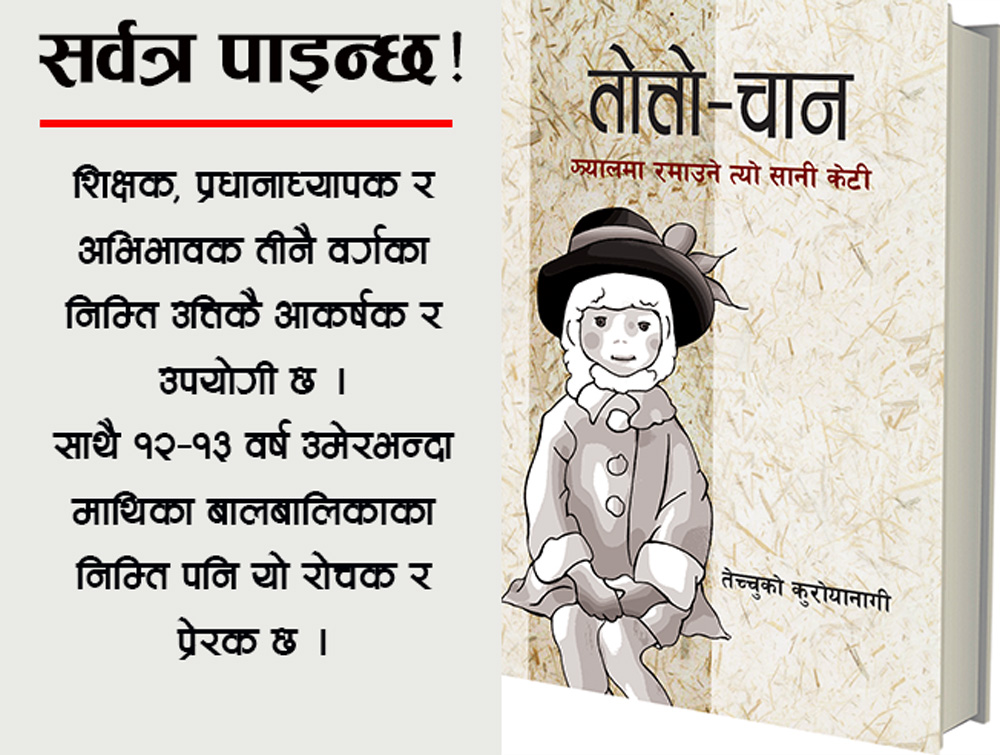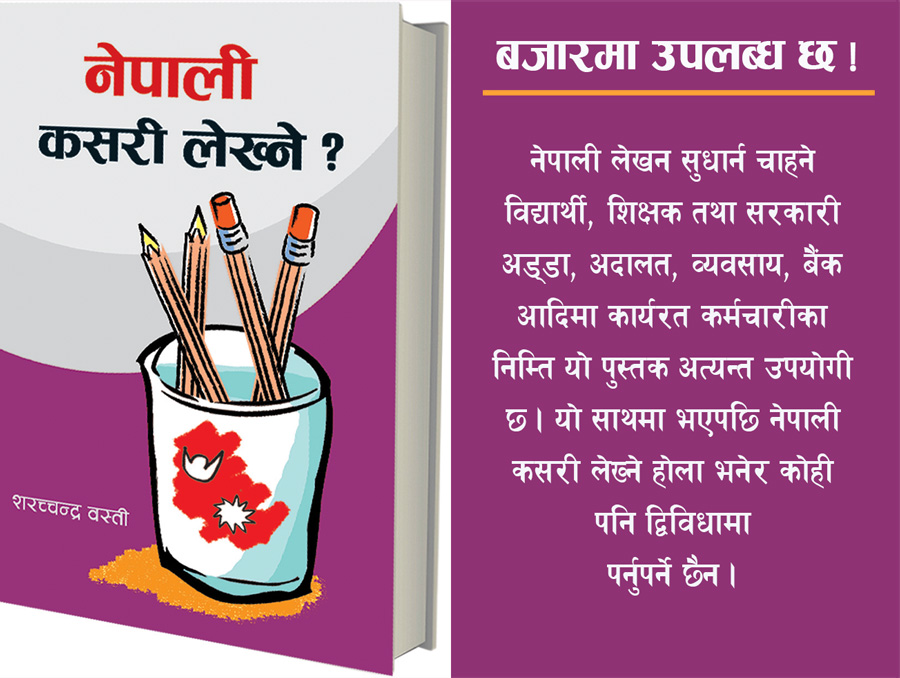Vocabulary Teaching Exercises
In the earlier issue, we looked generally at how to teach vocabulary in the classroom setting, providing some practical examples along the way. In this issue, we focus on how to help learners at the lower levels to enrich their vocabulary. Here, too, we provide practical tips for teachers to add to their own vocabulary storehouse.
A student tells the teacher why he could not come to class the day before using this expression: "Miss, yesterday I not come I sick." The meaning is conveyed even though the student did not use appropriate grammar. What this shows is that in order to speak and communicate you first need the words. While grammar is of course important, a good store of vocabulary is essential.
In the Nepali context, where students do not use English at home or in daily life and the teaching and learning of English is far from satisfactory, there is a great lack in terms of the vocabulary storehouse. In the English classrooms, the vocabulary terms tend to be presented in isolation to the context. Mostly, students are only taught the meaning of the new words, and they try to learn the words by heart rather than with understanding. This is why when it comes time to use English, the students feel great inadequacy.
Against such a challenge, the English teacher needs to keep in mind that the goal of vocabulary learning at the lower levels is to make the students able in selecting the appropriate words and using them properly in sentences. In what follows, we present ideas about teaching vocabulary effectively.
What to teach ?
Most of the effort in teaching vocabulary tends to be limited to presenting the meaning only, whereas other aspects are neglected, even those that would help in learning the meaning. The aspects we need to keep in mind in teaching vocabulary are the following:
a. Shapes: pronunciation and spelling
b. Word formation
c. Meaning
d. Usage
How to teach ?
How can we teach all these aspects in vocabulary class? Do we really need to teach them all? Can we teach these aspects in more than one class? These are the questions we often hear from English teachers when we talk about the vocabulary teaching. The answer is: we do need to teach all these aspects of vocabulary items, and it is indeed possible to teach all these aspects in a class.
When we teach new reading texts, the teacher can select key vocabulary items – or words – from the text and spend the whole class in teaching them. Also, the teacher can use class time in going back over and practising the vocabulary items learnt in previous classes. The teacher can also spend part of the lesson time in vocabulary practice activities, exercises and games.
Let's look at how different aspects of vocabulary can be taught at the primary level:
Pronunciation
You can list the new words on the board, pronounce them and ask the students to follow you. If you are not sure how the word is pronounced, you must consult the dictionary and also can listen to the CD that nowadays comes with the dictionary. The effective teacher must be confident about his/her own pronunciation before teaching in class.
In teaching pronunciation, the teacher must keep in minds that some of the sounds in English are alien to our local tongue. For example, in Nepal, the sound f in the word fan should be is often pronounced by joining two lips. The proper pronunciation actually comes from joining the lower lip with the edge of the upper teeth. First, practice saying fan by yourself before you teach it to the students. Once you are sure of your own pronunciation, demonstrate it before the class and then ask the pupils to follow you.
Spelling
One great problem for Nepali learners is that in English there is great difference between how a word is written and how it is spoken. For example, the sound 'k' is represented not only by the letter k, but also by the letters c and ch, as is seen from kite, cat or chemistry. Similarly the vowel i is represented by i, y, u, o as well as e, in words such as city, busy, woman, pretty, village. In the same way, the letter a is used to represent various vowels like æ, e,a:, Y in words like man, many, far, about.
Given such complexity, students should be given ample practice in the spelling of the new words. In class you can teach spelling by using the following techniques:
l Ask the students to copy the new words from the text
l Pronounce the words as the students write them in spelling
l Conduct dictation exercises: dictation games are possible
l Give the meaning and ask students to write the word
l Get students to unscramble words
l Get students to correct misspelled words
Meaning
It is important to alert pupils to the fact that the same word can have different meanings. For example, a term like head can have several meanings, including a part of the body, the start of a line, and intelligence. In elementary classes such as grade one, two and three, we try to teach words which have a clear, concrete meaning something that can be seen, touched or felt. There are various ways of teaching meaning to students, in the primary classes, some of which are as follows:
a) If possible, present the real object in context. Items such as watch, stapler, ruler, ink-bottle, glass or desk can be presented in class. You can present them in short conversation. For example, if you are teaching the word 'watch' you can have a quick demonstration, such as:
Teacher: Look, this is a watch (pointing to his or her watch). A watch. A watch.
Students: A watch.
Teacher: What is this? (with a gesture)
Students: A watch. (and so on.)
b) You can also point to the objects and teach their meaning. Words such as ceiling, wall and window can be taught through this technique.
c) If the real objects are not available for pointing, you can teach the meanings by using pictures and photographs. You can bring photographs or draw pictures on the board and teach the meaning. Words such as tree, bus, tiger, airplane, etc. can be taught like this.
d) If you are teaching action words such as jump, dance, walk, run, you can demonstrate the actions in class.
e) You may also present a context, asking student to work on the meaning by themselves. You can try the following example if you are teaching the term angry:
Ram and his father went to market. Ram saw a beautiful bag in a shop and asked his father to buy it for him. His father refused Ram’s request. Ram became angry with his father and started stamping his feet.
f) Words can also be taught by defining them in simple English. Sometimes students find it easier to understand meanings of the words if the teacher gives simple definitions.
e.g., crowd = many people together
tree= a tall plant
As teachers, when teaching vocabulary we should not limit ourselves to only one technique. Combining different techniques helps the learner to understand and 'feel' the meaning from different directions. Let us illustrate the point through some examples:

Word formation
When we present a new term to the students, it is also necessary that they understand what word classification it belongs to. Thus, a teacher should present the terms in different forms so that the students learn not only the class of the words but also the inflections and derivation. Different forms of the words should be given with the help of the appropriate sentences. For example: Your writing is beautiful. You write beautifully. Daman works in a factory. He is a worker. I did not sleep well last night. I am sleepy now.
Usage
Knowing words is not enough, as there cannot be good communication in the absence of usage. Learners should be able to use the words in appropriate sentences and contexts. The fact is appropriate usage does not get enough emphasis in classroom teaching. Part of the reason may be that teachers are themselves not comfortable enough with it. In order to promote proper usage, after teaching other aspects, the teacher should give example using the new words in sentences. In order to make sure the learners have understood, the teacher challenge the students to respond to his queries and comments relating to the term(s) just introduced.
Vocabulary practice activities
To repeat, only presenting new vocabulary items does not equip student with the skills of using them in speech and writing. The teacher should encourage students to practice through various activities. Such as:
Finding words in a word: Write elephant on the board, then ask your pupils to write as many words as they can using the letters from it, such as ant, pant, peel, help, plant, ten, net, etc. The student who makes most number of words would be declared winner.
Words from my name: Get students to draw a table as given below, writing their first name along the left row. Write down categories on the top row of the table. Ask the students to think of the words they know and fill in the blank spaces. Change the category every time you do this activity.
I spy: This is a very popular children’s game. One of the players makes a mental note of something in the classroom (or on a wall chart, etc.) and the other players have to guess what it is. He gives them a clue by giving them the first letter of the of the target word. If the answer were ‘desk’, he or she would say; "I spy with my little eye something beginning with…d". The fellow students would have to guess the word, giving many suggestions until the right one comes along.
Words Mapping: For this activity, give a word to which many other words are related and ask students how many words they can think of. For example, write the word school on the board and ask students to say one thing or idea each related to school. The possible responses are many: teacher,

bench, blackboard, homework, playground, assembly etc. The teacher can make the activity competitive by dividing the students into different groups.
Grouping words: This is a god way to recycle words. Ask students to put each of the words below into the correct list using each word once only. You can always develop this type of exercise form works in the textbook.
Task of the month
We invite the readers of Shikshak magazine to participate in our discussion on teaching and learning of English. So, we ask you to carry out some tasks and send us your answers along with your feedback. For starters, please send answers to the following questions:
a. Complete the table of the above game exercise "Words from my name" for Lekhnath. Make another table with your own name and do the same. Leave the spaces blank if you cannot find even one word for some category.
b. Use a dictionary and find the origin (etymology) of any two words in English. For this, refer to the article in the previous issue of Shikshak.



